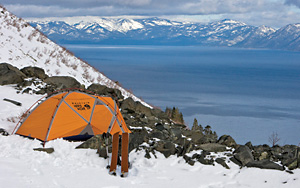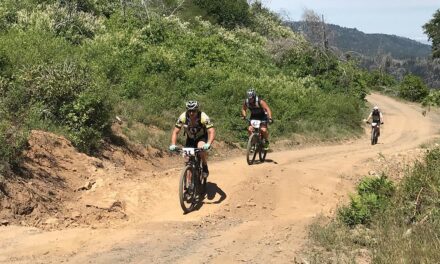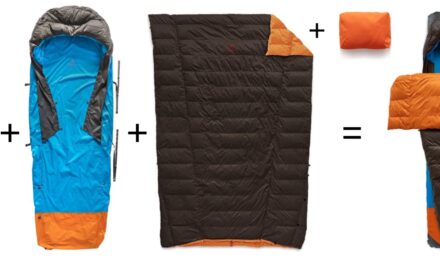- Tahoe’s Nevada Beach Tops the List of Hard-to-Book Campgrounds - 07/17/2024
- Cannabis Watershed Protection Program Cleans Up Illegal Grow Sites - 07/10/2024
- French Fire - 07/05/2024
Winter Camping in Comfort
Words and photos by Seth Lightcap

Known for realtively mild overnight lows and stellar weather, the Sierras are an idyllic range to learn how to winter camp.
Hey there Joe Camper! Whatcha got on winter?
While the Sierra wilderness is chock full of backpackers in the summer those same trails and camp sites empty faster than a shot glass come winter. Maybe it’s the snow, or the cold, or most likely both, but few avid Sierra explorers have the gusto for winter camping.
The truth is, winter camping has a bad rap. Sure it’s cold and occasionally uncomfortable but the frostbite horror stories you may have heard were probably from folks who were ill equipped and under prepared. Recent gear innovations have made things easier on winter campers. The current crop of four-season camping equipment works fabulously, and not just for surviving in a winter wonderland, but for thriving.
To help crush the myth of suffering and inspire you to push your snowshoe hikes or backcountry ski tours to the overnight level, I’ve broken down the path to a cozy night out by providing advice and gear recommendations for every step of the outing. If you can collect the right equipment and venture out during a good weather window, you’ll expe
rience the beauty and serenity of the Sierra like you’ve never seen before and comfortably stretch your camping horizons into this fabulous ‘fourth‘ season.
Getting To Camp
When sliding down the snowy trail, stress and suffering travel hand in hand. If you’re to enjoy a pleasant night out in the frozen wilderness you need to eliminate or minimize as many stresses on your body as possible.
The first place stress can rear its ugly head is on the way to camp. No matter how you’re traveling, via snowshoes, skis, or splitboard, it’s important to make sure your gear is dialed in for the journey. Leaving the trailhead with rickety snow-travel equipment is a recipe for disaster and fixing gear mid-route always wastes time and usually leaves you wet and cold as a bonus.
Just like a mid-summer overnight trip, the goal is to arrive at your intended winter campsite happy and warm. Wearing solid waterproof footwear and the proper layers and double checking the condition of your gear before you leave the car will help ensure that happens.
Setting Camp
When it’s time to set camp, first thing to do is take a close look at the area around you. Are there avalanche dangers lurking above? Are there any terrain features or trees that may protect you from the wind? Are there any dry areas where you can cook and relax off the snow?
Campsites in avalanche paths are an obvious no go, but with the other variables you’ll have to weigh the benefits of a couple locations. If wind or weather will be an issue lean toward a protected nook, but otherwise look for comfort features such as log benches, cooking slabs, or south-facing zones with good morning/evening sunlight. Once you’ve pinpointed the ideal spot, drop your pack, put on some warm layers, and break out the tent and shovel.
The great thing about snow camping is that you can dig out a flat tent platform just about anywhere, even gentle slopes. To make the platform, throw down your tent footprint to gauge how big the pad will need to be, then use your shovel or skis to evenly compact the snow in that area. You’ll get the best sleep on a flat and consolidated platform, so take the time to construct a sweet spot when conditions and space allow.
As you unfold the tent take note of the wind direction and any slight pitch to your platform. Lay out the tent with your feet into the wind and your head higher than your feet. Try not to maul your platform when pitching the tent and be sure to anchor the shelter down solid. Standard tent stakes are typically worthless in loose snow so get creative by burying shards of rock or sticks as anchor points.
Though not every winter night in the Sierra will demand it, investing in a four-season tent is highly advised. The mesh paneling on most three-season tents don’t trap heat well compared to four-season models. If you’re in the market for a tent upgrade check out Mountain Hardwear’s EV2 or Black Diamond’s Bomb Shelter. Both are built to withstand hurricane-force winds and heavy snow yet are a breeze to set-up.
Cooking and Relaxing
Your tent is pitched! Time to relax and eat. Bad weather or extreme cold may force you to hunker down in the tent to make dinner. But beware: cooking in the open air is safer and much preferred over steaming up the tent with a stove.
To cook and chill outside in comfort you’ll need to bring the right stuff for keeping your body and mind warm. Beyond the obvious stove, food, warm layers and gloves, a few indispensable items include down booties, a foam sitting pad, and plenty of hot beverages.
Pick a kitchen that has at least a flat spot to balance a stove but preferably a little dry ground to stretch out on. The first thing to cook up is hot water. Start your meal with a cup of tea or cocoa as it will warm you from the inside out and help keep you hydrated at a time when you’ll have no interest in drinking cold water.
Choosing a dinner menu that is easy to prepare, tasty, and satisfying is crucial. Only bring food that you know you will enjoy. If you’re at a loss for ideas check out the organic freeze dried backpacking meals from Mary Jane’s Farm or scour the backpacking web forums for recommendations. Winter camping is also a great time to eat in courses. Prepare a quick hot soup with crackers as an appetizer, use the left over water to start your main entrée, then finish off the feast with another cup of tea and some chocolate.
Canister gas stoves like the Jetboil work fine for winter camping in the Sierra, but if you plan on staying out for several nights you’ll want to pack a liquid gas stove like the MSR WhisperLite or the MSR XGK-EX to maximize fuel space and efficiency. You’ll also find that bringing two pots will come in handy as you can trade out melting snow and cooking without turning off the stove.
Sleeping
Feeling well fed and ready for bed? Before you kill the stove, boil up one more round of snow for a hot water bottle to go. With this heater core in hand, batten down your camp so that nothing blows away overnight and go to the bathroom again. As you arrive at your tent door brush off all the frozen crusted snow from your pants and boots before entering.
Crawling into the tent make sure your sleeping pad is fully inflated and try not to punch big divots in the tent platform. If you haven’t already unpacked your sleeping bag bust that out next, fluffing it to maximize loft. With your feet happily in your bag you can start arranging other gear around you. Placing a jacket or backpack underneath the foot of your pad works well as back-up insulation in case your toes find their way off the pad during the night.
Assuming you’ve constructed an ample platform, your comfort overnight will be determined by the warmth of your sleeping bag. Nothing sucks more than waking up in the middle of the night shivering. Sleeping bags rated to zero degrees are ideal for the Sierra. Although it rarely gets that cold, the extra insulation will allow you to wear a single layer to bed. Sleeping in multiple layers can help an under-rated bag, but in general it’s not ideal as the bulk of the clothing eliminates the space available to trap warm air. The body-warmed air trapped below your draft collar is what keeps you toasty all night long.
Four-season sleeping bags and pads have come down in price dramatically in recent years so don’t hesitate to upgrade if you suspect your current sleeping bag or pad may be insufficient. A zero-degree rated bag like the North Face Snowshoe can be found for $200, while a self-inflating pad like the Therm-a-rest ProLite Plus can be had for just over $100.
Learn More
Despite the tricks you’ve just picked up, there is no substitute for real experience when learning how to camp comfortably year round. If you’re excited to give winter camping a try, but hesitant to head out without more guidance look into the Snow Camping 101 classes offered this winter by the Tahoe Rim Trail Association. These one-night excursions into the Tahoe backcountry will be led by experienced guides and are open to those 21 and older. Two classes are scheduled: Jan. 16-17 and Feb. 27-28.
For more info contact the TRTA at (775) 298-0238 or email programs@tahoerimtrail.org.













